Animal Corner
Discover the many amazing animals that live on our planet.

Brazilian Wandering Spider
The Brazilian Wandering Spider (Phoneutria fera) is an aggressive and highly venomous spider . It was first discovered in Brazil hence its name. However, this genus is known to exist elsewhere in South and Central America .
The Brazilian Wandering spider is a member of the Ctenidae family of wandering spiders.
The Brazilian Wandering spider appeared in the Guinness Book of World Records 2007 for being the most venomous animal .
In this particular genus, there are five known similar species whose members are also highly venomous. They include some of the relatively few species of spiders that present a threat to human beings.
Brazilian Wandering Spider Characteristics
The Brazilian wandering spider can grow to have a leg span of up to 4 – 5 inches. They are large hairy spindly-looking spiders who have eight eyes, two of which are large. Brazilian wandering spiders are fast-moving spiders, their legs are strong and spiny and they have distinctive red jaws which they display when angered.
The Brazilian wandering spider is not a Tarantula . Brazilian wandering spiders are not even in the same family group. Tarantulas are harmless to humans and are mostly ambush killers who wait for prey to come to them. Brazilian wandering spiders are active hunters. Brazilian wandering spiders and Tarantulas do have one thing in common, however, they do not eat bananas.
Brazilian Wandering Spider Habitat and Spider Webs
The Brazilian Wandering spider is so-called because it wanders the jungle floor, rather than residing in a lair or maintaining a web. This is another reason it is considered so dangerous. In densely populated areas, the Brazilian Wandering spider will usually search for cover and dark places to hide during daytime, leading it to hide within houses, clothes, cars, boots, boxes and log piles. This usually causes accidents when people disturb them.
The Brazilian Wandering spider is also called the ‘banana spider’ as it is occasionally found within shipments of bananas. As a result, any large spider appearing in a bunch of bananas should be treated with due care.
Brazilian Wandering Spider Diet
Adult Brazilian Wandering spiders eat crickets, other large insects, small lizards and mice. Spiderlings of this species eat flightless fruit flies and pinhead crickets.
Brazilian Wandering Spider Reproduction
All spiders produce silk, a thin, strong protein strand extruded by the spider from spinnerets most commonly found on the end of the abdomen. Many species use it to trap insects in webs, although there are many species that hunt freely such as the Brazilian Wandering spider. Silk can be used to aid in climbing, form smooth walls for burrows, build egg sacs, wrap prey and temporarily hold sperm, among other applications.
Brazilian Wandering spiders reproduce by means of eggs, which are packed into silk bundles called egg sacs. The male spider must (in most cases) make a timely departure after mating to escape before the females normal predatory instincts return.
Mature male spiders have swollen bulbs on the end of their palps for this purpose and this is a useful way to identify whether the spider is male or female. Once the sperm is inside the female spider, she stores it in a chamber and only uses it during the egg-laying process, when the eggs come into contact with the male sperm for the first time and are fertilized. The Brazilian Wandering spiders life cycle is 1 – 2 years.
Brazilian Wandering Spider Venom
Bites from the Brazilian Wandering spider may result in only a couple of painful pinpricks to full-blown envenomed. In either case, people bitten by this spider or any Ctenid should seek immediate emergency treatment as the venom is possibly life threatening.
The Phoneutria fera and Phoneutria nigriventer (two species of wandering spider) are the two most commonly implicated as the most vicious and deadly of the Phoneutria spiders.
The Phoneutria not only has a potent neurotoxin, but is reported to have one of the most excruciatingly painful envenoms of all spiders due to its high concentration of serotonin. They have the most active venom of any living spiders.
One of their members, the Brazilian Huntsman, is thought to be the most venomous spider in the world. Brazilian wandering spiders are certainly dangerous and bite more people than any other spiders.
Check out more animals that begin with the letter B
More Fascinating Animals to Learn About
About joanne spencer.
I've always been passionate about animals which led me to a career in training and behaviour. As an animal professional I'm committed to improving relationships between people and animals to bring them more happiness.
Understanding the Wandering Spider: Quick Essential Facts

Wandering spiders are a group of venomous arachnids found primarily in South America.
Among these, the Brazilian wandering spider is particularly known for its potent venom and unique behavior. They are often referred to as “banana spiders” due to their frequent encounters with humans in banana plantations.
As a reader, you might be interested in learning more about these fascinating creatures, including their habitat, hunting techniques, and the effects of their venom.
In this article, we will delve into the world of wandering spiders and provide you with all the essential information to satisfy your curiosity.

Scientific Classification and Naming
The wandering spider belongs to the genus Phoneutria , which is a part of the Ctenidae family.
These spiders are known for their potent venom and aggressive behavior. Here is the scientific classification of the wandering spider:
- Kingdom: Animalia
- Phylum: Arthropoda
- Subphylum: Chelicerata
- Class: Arachnida
- Order: Araneae
- Family: Ctenidae
- Genus: Phoneutria
Within the genus Phoneutria, two species are particularly noteworthy: Phoneutria fera and Phoneutria nigriventer, also known as P. nigriventer . These spiders are primarily found in South America and other tropical regions.
Phoneutria fera and P. nigriventer differ in some aspects. Let’s compare their features using a table:
Some key characteristics of the wandering spiders in the genus Phoneutria include:
- Potent venom that can be dangerous to humans
- Nocturnal hunters and are active at night
- Equipped with long, spiny legs for capturing prey
- Aggressive defenders of their territory
By understanding the scientific classification and differences between Phoneutria species, you can better appreciate the diversity and fascinating biology of these wandering spiders.
Identification and Appearance
Color and size.
The wandering spider, also known as the banana spider, has a distinctive appearance that can help you easily identify it in the wild.
They usually have a combination of hairy brown and black colors on their body. Their size can vary, but they are generally considered large spiders. Their size can range from 1 to 2 inches in body length.

When it comes to wandering spider’s leg span, these creatures can have an impressive reach. Their leg span can extend up to 5-6 inches.
Some key characteristics of a wandering spider’s legs include:
Habitat and Distribution
Wandering Spiders are known to inhabit various environments, including rainforests and tropical forests.
These spiders can adapt to different habitats based on their needs and availability of food sources. They prefer warm and humid places, as these conditions suit their growth and reproduction.
Geographical Coverage
Wandering spiders are found in Central and South America .
They live in forests from Costa Rica to Argentina, including Colombia, Venezuela, The Guianas, Ecuador, Peru, Bolivia, Brazil, Paraguay, and Northern Argentina.
They may also be present in some parts of the United States, particularly in the northern part of southern America.
However, they don’t inhabit countries like Australia. In summary, the Wandering Spider is mostly prevalent in the following areas:
- South America
- Central America
- Southern parts of the United States
Types of Wandering Spiders
Here’s a brief description of the major types of wandering spiders.
Brazilian wandering spiders
Also known as armed or banana spiders, these spiders are nocturnal and don’t make webs.
They are known to have been transported outside of South America in banana shipments.
Phoneutria nigriventer
These spiders contain neurotoxins that can cause cerebral changes and breakdown of the blood-brain barrier .
Their venom is medically significant and has been used in manufacturing drugs. Their bites may be fatal to children.
Ctenus captiosus
Also known as the Florida false wolf spider or tropical wolf spider, this species is found in the United States.
Some species of these spiders are large and scary-looking, but they’re only mildly venomous. Their venom is comparable to a bee sting.
Other types of wandering spiders include: Acantheis, Acanthoctenus, Africactenus, and Afroneutria.

Behavior and Diet
Aggression level.
Wandering spiders, as their name suggests, are known for their aggressive behavior .
While they won’t attack without provocation, if they feel threatened, they will not hesitate to defend themselves.
This is especially true during mating season.
Prey and Predators
In their natural habitat, wandering spiders primarily feed on insects and small vertebrates, such as:
- Insects like ants and moths
- Small amphibians
This diverse diet allows them to thrive in various ecosystems.
However, they are not top predators, as their natural predators include larger birds, mammals, and other spiders.
Nocturnal Activities
Wandering spiders are nocturnal creatures , which means they are active during the night.
During the day, they remain hidden in their retreats, often made from rolled-up leaves or small crevices.
At night, they leave their hiding spots to search for prey using their strong hunting skills.

Venom and Its Effects
Composition of venom.
The venom of the wandering spider is a complex mixture containing several toxic components.
Its main component is a potent neurotoxin, which can have severe effects on your nervous system 1 . Here’s a brief overview of its composition:
- Neurotoxins
Symptoms and Severity
A wandering spider’s venomous bite can cause a wide range of symptoms, depending on the severity of envenomation. These symptoms may include 2 :
- Mild to moderate pain
- Redness and swelling at the bite site
- Irregular heartbeat
- Difficulty breathing
- Blurred vision
- High blood pressure
Some severe cases may result in life-threatening complications, such as respiratory failure or even death 2 .
Medical Treatment and Antivenom
If bitten by a wandering spider, it’s crucial to seek immediate medical attention. Treatment often involves the following steps:
- Cleaning and immobilizing the affected area
- Monitoring and managing the symptoms
- Administering antivenom if it’s available and appropriate, depending on the severity of envenomation 3
Antivenom is specific to the venom of the wandering spider and can help neutralize its effects.
However, the availability of antivenom may be limited in some regions 3 .
Always remember that prevention is better than cure: learning how to identify and avoid wandering spiders is the best way to stay safe.

Reproduction and Mating
Mating ritual.
When it’s time for reproduction, the wandering spider undergoes an intriguing mating ritual.
The male spider performs a dance to attract the female by displaying his brightly colored legs and vibrating his body.
During the process, the male also produces a sperm web and transfers his sperm to the female’s reproductive organs using his pedipalps.
Egg Sacs and Offspring
After the mating process, the female wandering spider will create an egg sac to protect her eggs.
The sac consists of silk and can hold hundreds of eggs. She then attaches it to a safe hiding place, usually against a protective surface or within a secure web.
The female often guards the egg sac to ensure the protection of her offspring until they hatch.
Once the spiderlings hatch, they are known to be highly independent.
They disperse quickly and start their own journey, fending for themselves soon after emerging from the egg sac.
As they grow, they’ll go through a series of molts before reaching adulthood and beginning their own reproductive cycle.
Danger and Defense Mechanisms
The Wandering Spider is known to be one of the most dangerous spiders in the world.
Although they can potentially kill humans, fatalities are rare due to their reluctance to bite.
Oddly enough, their venom can cause an involuntary erection in men, alongside other painful symptoms.
Here are some ways the Wandering Spider protects itself and displays its dangerous nature:
- Fangs : These spiders are equipped with strong, sharp fangs that can easily pierce human skin, allowing them to inject their venom with ease.
- Venom : Their venom is potent and can cause severe pain, inflammation, and other adverse effects. In rare cases, it can even lead to death.
While interacting with Wandering Spiders, be cautious and observe them from a safe distance.
Knowing their defense mechanisms will help you respect their space and avoid any unpleasant encounters.
Remember, it’s essential to be informed and aware when dealing with these fascinating, yet dangerous creatures.

Comparison with Other Dangerous Spiders
Comparison to black widow.
The black widow spider is notorious for its potent venom, but the wandering spider has a stronger venom overall.
Both spiders are capable of causing severe symptoms, but the black widow’s venom is primarily neurotoxic, affecting your nervous system.
In contrast, the wandering spider’s venom can cause both neurotoxic and cytotoxic effects, potentially damaging your nerves and cells.
- Potent neurotoxic venom
- Red hourglass marking
- Stronger venom (neurotoxic and cytotoxic)
- No distinct marking
Comparison to Brown Recluse
The brown recluse spider is known for its necrotic venom that can lead to tissue damage and sometimes requires medical intervention.
While both the brown recluse and wandering spider can produce venomous bites, wandering spiders are considered more dangerous due to the potency of their venom and the severity of their bite symptoms.
- Necrotic venom
- Dark violin-shaped marking
Comparison to Wolf Spider
Wolf spiders are frequently mistaken for more dangerous spiders due to their size and appearance.
Although they can bite, their venom is not particularly potent and generally only causes mild itching, redness, and swelling.
In comparison, the wandering spider’s venom is far more dangerous, and its bite can result in serious symptoms, requiring immediate medical attention.
- Large and hairy
- Smoother appearance
Comparison to Sydney Funnel-Web Spider
The Sydney funnel-web spider is another highly venomous spider known for its potentially lethal bites.
While both spiders possess powerful venom, the wandering spider has a broader range of symptoms due to the combination of neurotoxic and cytotoxic effects.
In conclusion, wandering spiders are more dangerous than wolf spiders but their venom’s effects are more varied compared to black widows, brown recluses, and Sydney funnel-web spiders.
Be cautious around these spiders and seek medical help if bitten.
Interesting Facts and Guinness World Records
The Wandering Spider, also known as the Brazilian Wandering Spider, is a fascinating creature that has caught the attention of many.
They belong to the genus Phoneutria , which means “murderess” in Greek, giving you an idea of their potency. Let’s explore some interesting facts about this spider and its place in the Guinness World Records.

First, you might be curious about their venom. The Wandering Spider is known for having one of the most potent venoms among spiders.
In fact, it holds the Guinness World Record for the most venomous spider. Their venom contains a potent neurotoxin that can cause severe symptoms, including difficulty breathing, high blood pressure, and intense pain.
Apart from their venom, their behavior is also quite intriguing. These spiders are called “wandering” because they are known for actively hunting their prey rather than spinning webs to catch them.
They are mostly nocturnal creatures and, during the day, can be found hiding in logs or dark crevices.
Here are a few more notable characteristics of the Wandering Spider:
- Females are larger than males, with a body length of up to 1.6 inches (4 cm).
- They have eight eyes, arranged in two rows, which help them in hunting.
- The Wandering Spider is primarily found in Central and South America, particularly in Brazil.
- They are known to show aggression when threatened.
While the Wandering Spider is a marvel of the arachnid world, it’s essential to keep a safe distance from them due to their venomous nature.
However, their unique characteristics and record-breaking venom potency make them a fascinating subject for those interested in the natural world.
Prevention and Safety Measures
To protect yourself from wandering spiders, there are some simple safety measures you can take.
Firstly, be cautious in areas where these spiders may live, such as dark and warm spaces. For example, avoid reaching into crevices or lifting piles of wood without inspecting them first.
Always wear appropriate shoes when outdoors, particularly in wooded or grassy areas. This can help prevent bites on your feet or ankles.
Reduce the risk of wandering spiders entering your home by sealing gaps and cracks. This minimizes the chance of the spiders finding a way inside.
Regularly clean your living spaces, paying special attention to dark and hidden areas. By maintaining a clean environment, you’ll discourage wandering spiders from making themselves at home.
When out in nature, avoid disturbing spider habitats like webs or egg sacs. This can prevent agitating wandering spiders, reducing your chance of accidental encounters.
Remember, wandering spiders can be dangerous, but by taking these precautions, you can significantly reduce your risk of encountering them or being bitten. Stay safe and always be aware of your surroundings.
In summary, wandering spiders, particularly those in the genus Phoneutria, are a group of venomous arachnids predominantly found in Central, South America and parts of Southern United States.
These spiders, including the Brazilian wandering spider, are known for their potent venom, nocturnal hunting habits, and aggressive defense mechanisms.
Their venom, containing neurotoxins and other components, can cause severe symptoms in humans, making them one of the most dangerous spider species.
Despite their fearsome reputation, fatalities are rare, and they play a vital role in their ecosystems.
It’s important to respect their space and take preventive measures to avoid encounters. Understanding these spiders’ behavior, habitat, and characteristics can help in appreciating their role in nature while ensuring safety.
https://www.ncbi.nlm.nih.gov/pmc/articles/PMC2857337/ ↩
https://www.ncbi.nlm.nih.gov/pmc/articles/PMC3851068/ ↩ ↩ 2
https://www.ncbi.nlm.nih.gov/pmc/articles/PMC6560916/ ↩ ↩ 2

Bugman aka Daniel Marlos has been identifying bugs since 1999. whatsthatbug.com is his passion project and it has helped millions of readers identify the bug that has been bugging them for over two decades. You can reach out to him through our Contact Page .

Piyushi is a nature lover, blogger and traveler at heart. She lives in beautiful Canada with her family. Piyushi is an animal lover and loves to write about all creatures.
Related Posts
8 comments . leave new.
Hi Michele, I am an Ecuadorian scientist and specialized on spiders, I would like to find one like yours, I can say that, almost without doubt, you found the Phoneutria itself, it is the Phoneutria fera, look at this picture: http://www.google.com/imgres?imgurl=http://4.bp.blogspot.com/-bFH9qzT0F7U/T_2sZuk6xAI/AAAAAAAAAGY/8jnMVcPOcNI/s1600/phoneutria_fera2.jpg&imgrefurl=http://rangerbaiano.blogspot.com/2012/07/animais-peconhentos-e-venenosos.html&usg=__iCWEz7S86xub6RAyvXTER6HBaco=&h=864&w=834&sz=215&hl=es-419&start=6&zoom=1&tbnid=jjOROVO9h-vKXM:&tbnh=145&tbnw=140&ei=99eRUY6xKo2K9QTLvYCoDQ&prev=/search%3Fq%3Dphoneutria%2Bfera%26sa%3DN%26hl%3Des-US%26sout%3D1%26tbm%3Disch%26prmd%3Divns&itbs=1&sa=X&ved=0CDYQrQMwBQ Can you see the similarities?, unfortunately the spider might be in a better life today 🙂 Another thing, when you want identifications you should take a picture in front, the under part, and the upper part, as well as some characteristics about behaviour like how they react when you approach. The Phoneutria is a very agressive one.. best wishes, bye.
Hi Miguel, Thanks so much for the comment. This is a seven year old posting and we did not have the ability to post comments when it was originally posted online. We have made an update on What’s That Bug? and your comment is greatly appreciated.
Ah, there is also needed the size and the picture of its face so we can see the eye arrangement, depending on that it could also be pisauridae, but I stay in Ctenidae..
This is a female Cupiennius sp. wandering spider.
Perhaps surprisingly, this ubiquitous large spider of the Mindo area appears to be undescribed to species level.
Although one is indeed best advised to exercise caution in the presence of large ctenids, members of the genus Cupiennius are not known to be dangerously venomous (Barth, 2002). By way of confirmation, my girlfriend, Shannon Bowley, managed to be bitten by a mature female of this Mindo species in 2013 – she felt only mild effects, equivalent to a bee sting.
Thanks for this valuable information.
I’m planning a trip to Ecuador and I’m fearing these spiders. Do they get in houses? Any tips to keep them out, so I can sleep at night?
Leave a Reply Cancel reply
Your email address will not be published. Required fields are marked *
Notify me of followup comments via e-mail. You can also subscribe without commenting.
Post Comment
Recent Posts
Cabbage Tree Emperor Moth: Quick Facts and Essential Info
Do Boxelder Bugs Bite? Separating Fact from Fiction
Is a Scorpion Fly Dangerous? Uncovering the Truth About This Intriguing Insect
Orbweaver Spiders: Your Go-To Resource for Successful Encounters
Are Cat Faced Spiders Poisonous? Uncovering the Truth
- Anura (egg stage)
- Ephemeroptera
- From the Archives
- Hymenoptera
- Insects General
- Lepidoptera
- Malacostraca
- Megaloptera
- Microcoryphia
- Nematomorpha
- Non Insects
- Nymphalidae
- Papilionoidea
- Phasmatodea
- Phthiraptera
- Platyhelminthes
- Pseudoscorpiones
- Pycnogonida
- Raphidioptera
- Siphonaptera
- Thelyphonida
- Thysanoptera
- Trichoptera
- Trombidiformes
- Turbellaria
- Uncategorized

Fact Animal
Facts About Animals

Brazilian Wandering Spider Facts
Brazilian wandering spider profile.
There are more than 50,000 species of spider, and the vast majority are less dangerous than a honeybee. Almost none are aggressive, and of those with medically significant venom, only a small percentage are capable of causing death. So, on the whole, arachnophobes are just being a bit silly.
But there’s one spider that vindicates all of these fears, and few animals are as globally renowned to be a serious threat to human lives as the Brazilian Wandering Spider .
Brazilian Wandering Spiders are actually 9 species of spider in the same genus ‘Phoneutria’, one of which is found in Central America, with the rest in South America.
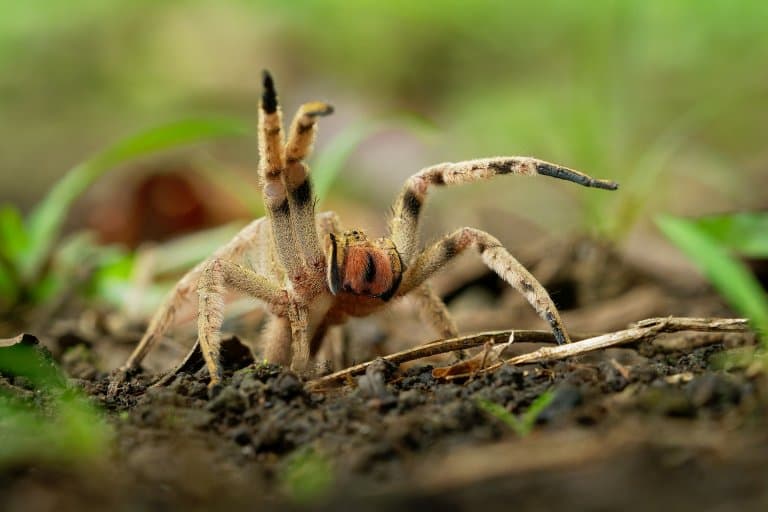
Brazilian Wandering Spider Facts Overview
These spiders are called wandering spiders because of instead of spinning a web to wait for food, or occupying a lair, they spend their night wandering in the leaf litter of the jungle floor for prey.
The sensitive hairs on its body help detect vibrations of passing prey, and it will feed on insects, lizards, frogs and any animals as large as itself.
During the day they will hide under logs, rocks, or inside termite mounds and banana plants. They will also sometimes wander into urban areas and homes, where they can come into contact with humans.
Brazilian wandering spiders are aggressive , dangerous and frightening. For once, this is an animal you should be wary of.
The females are larger, around 50% heavier than males, and produce more venom, and this might be a clue as to why their Greek name translates to “ Mudress” . These spiders will often stand and fight and have an intimidating threat display.
The potency of their venom is one of the reasons they’re so dangerous, and their ability to hide away in fruit and shoes explains why most bites are on extremities.
Interesting Brazilian Wandering Spider Facts
1. armed spiders.
In Brazilian, these are sometimes known as armed spiders, on account of their elongated front legs.
They can convey quite a bit of information with these legs, and as wandering spiders, use them to get about the forest, looking for food.
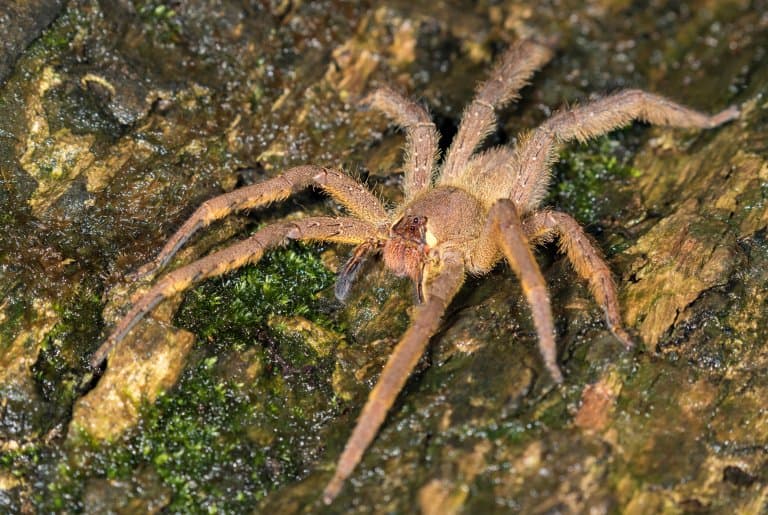
2. Banana Spiders
They’re also sometimes called ‘banana spiders’ on account of their status as a stowaway on popular fruit imported from the tropics.
This is becoming less common as stricter regulations ensure there’s less contamination of fruits, but there’s always a chance your next bunch of bananas will have a family of these spiders living inside it.
3. They have the largest venom glands of any spider
Females produce more venom than males, but both sexes have enormous venom glands. These glands are even more impressive when you consider the size of the spider is significantly less than the largest around.
The venom glands of the Brazilian Wandering Spider are over a centimetre long, and this is all housed inside the bright red chelicerae (mouth parts) which they are quick to display whenever they get upset. 1
4. They’re aggressive
These spiders can grow quite large and have long, brightly-coloured legs. Unlike most spiders, they’re known to stand their ground when threatened and are far quicker to bite than many other species.
They’ll still try to scurry away where possible, and they’re not out to get anybody.
But where most other species will flee, the wandering spiders’ aggression does make it more likely to be involved in incidents.
Most bites are on fingers and toes, a sign that they’re being stepped on or grabbed inadvertently. When the spider feels cornered, it’ll rear up on its back legs and waves its colourful arms around as a warning.
Then it’ll sway side to side, beckoning you to have a go. Anything foolhardy enough to call this bluff gets a wealth of envenomation effects. 2 3
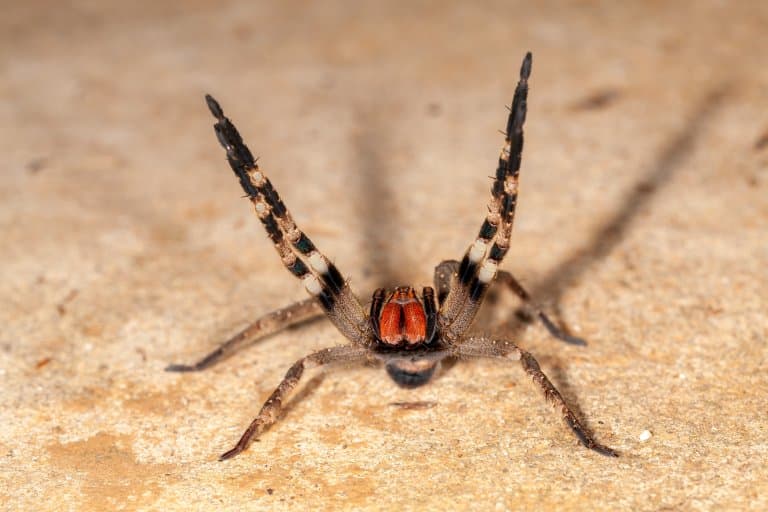
5. They give some men erections
There are ways to accomplish this with fewer side effects, but a bit from a Brazilian wandering spider does come with a certain Viagral quality.
This isn’t as fun as it might sound. Prolonged erections in this manner are likely to harm and destroy muscles and blood vessels in the penis and could cause irreparable damage.
Besides this, the assault on the central nervous system that comes with envenomation by this spider doesn’t sound worth it. 4
6. And some people die
This assault brings with it a whole host of unpleasant symptoms. Seizures, foaming at the mouth, inability to speak, collapse, and a host of other miserable experiences.
Paralysis is possible, as is cardiac shock. Blood vessels can burst in the brain, or anywhere else, and in many cases, this can be enough to kill a person.
This spider has one of the most potent venoms of all, and there are multiple legitimate records of death as a result of bites.
7. But they’re rarely fatal
While the Brazilian wandering spider is potentially one of the most dangerous spiders in the world, there is some evidence to suggest it gives a dry bite, defensively.
This means that despite exceptionally toxic venom, the amount actually injected is less than some of the other contenders, and this is what makes it typically less lethal than the Australian funnel webs.
These spiders are classified as Dangerous Wild Animals and would therefore require a special permit to keep. Bites from wandering spiders are common in South America, but antivenom is often readily available, and they rarely result in death.
In most cases, lethal bites are cases of a very young or very old victim, and few people of healthy age are killed. 5
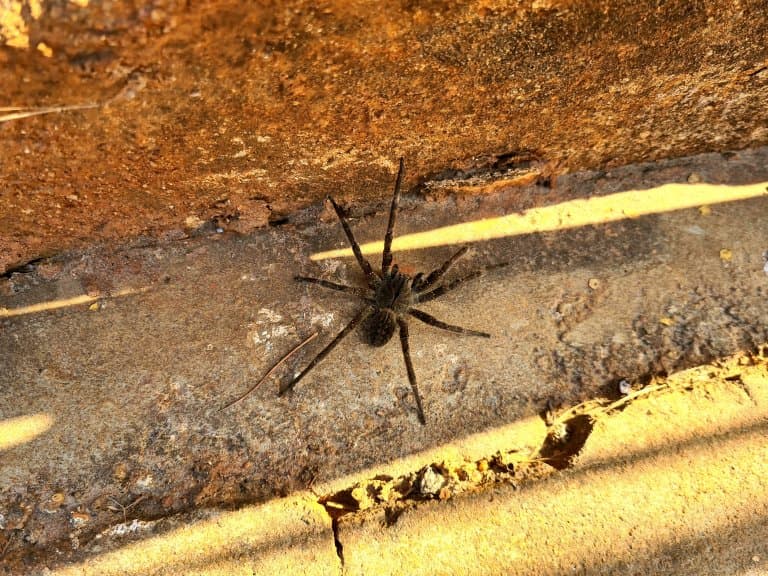
8. They do invade the UK sometimes
These unquestionably scary spiders show up in supermarkets in the UK on occasion, having hitched a ride on banana shipments.
On more than one occasion they’ve made their way into shoppers’ homes, but it doesn’t appear that there are any cases of them biting people as a result.
These spiders aren’t suited for temperate climates and don’t survive Winter, so there’s no risk of them multiplying.
Brazilian Wandering Spider Fact-File Summary
Scientific classification, fact sources & references.
- PeerJ. (2017), “ Dimensions of venom gland of largest venom glands in all spiders ”, Bio Numbers.
- Dave Clarke (2010), “ Venomous spider found in Waitrose shopping ‘beautiful but aggressive’” , The Guardian.
- “ Phoneutria Perty (Arachnida: Araneae: Ctenidae) ”, UF-IFAS University of Florida
- Kátia R.M. Leite (2012), “ Phoneutria nigriventer spider toxin Tx2-6 causes priapism and death: A histopathological investigation in mice ”, Science Direct.
- “ Brazilian wandering spiders: Bites & other facts ”, Live Science.

A home for Tarantula, Spider, Scorpion and Arachnid Enthusiasts.
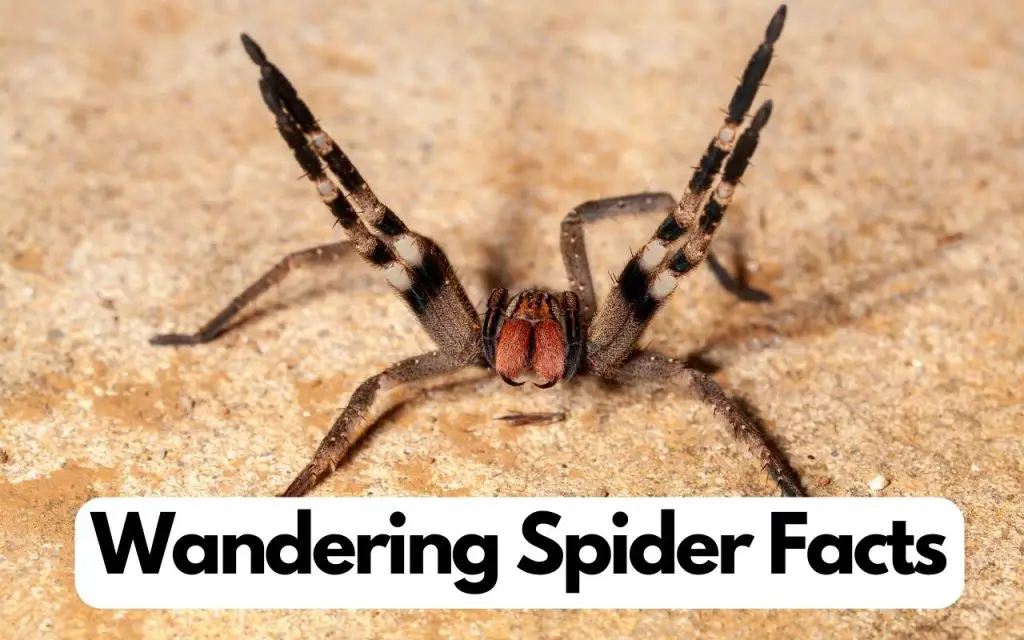
Brazilian Wandering Spider facts
Last updated on July 12th, 2023 at 01:48 pm
When you think of deadly spiders, there are a few names that spring to mind – but none more infamous than the Brazilian Wandering Spider. This species is reputed to have the most toxic venom of any spider, having a bite which causes horrendous side-effects like priapism and convulsions.
What you may not know, however, is that the Brazilian Wandering Spider name is actually used for a few species. The most common, and perhaps the most medically significant in the group are Phoneutria nigriventer and Phoneutria fera .
In this post, I’ll tell you more about these two species, from where they live, to what they eat. To keep things simple, I’ll just refer to them both as the “Brazilian Wandering Spider”, given how similar they are. Let’s dive in…
Quick Facts
To kick things off, here are some fascinating factoids about the Brazilian Wandering Spider:
- They belong to the genus ‘Phoneutria’, which translates to ‘murderess’ in Greek.
- They are known for their highly potent venom.
- Wandering Spiders are nocturnal creatures.
- They are also known as ‘banana spiders’ due to their tendency to hide in banana plants.
- They are not web-weavers but active hunters. This is called ‘cursorial’ hunting.
- It’s considered one of the most dangerous spiders in the world.
Other Common Names
The Brazilian Wandering Spider goes by several other names. The most common is the ‘banana spider’, thanks to their notorious habit of stowing away in banana shipments. In their native Portuguese, they’re known as ‘aranhas-armadeiras’ , translating to ‘armed spiders’ – a reference to their aggressive defense posture.
Brazilian Wandering Spider Venom
Possessing one of the most potent venoms among spiders, the Brazilian Wandering Spider’s bite is a cause for concern. Its venom is a complex cocktail of toxins, proteins, and peptides.
The main component that gets everyone’s attention is the neurotoxin, called PhTx3 , which can interfere with the functioning of our nervous system, leading to a variety of symptoms.
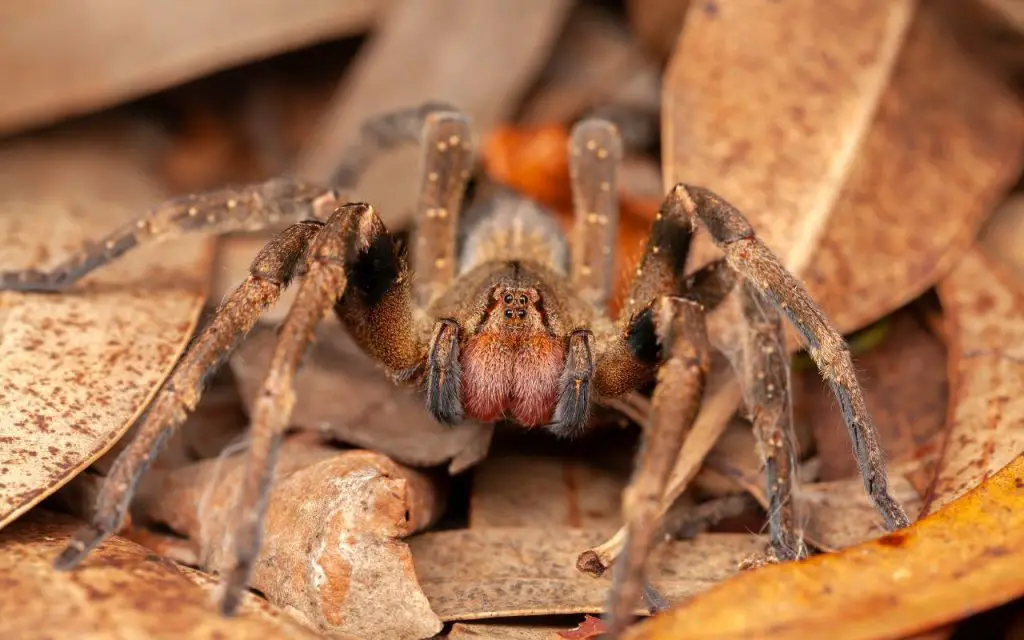
What’s the Benefit of Having Such Strong Venom?
With venom potent enough to kill a human, one might wonder why this spider needs such a powerful weapon. The answer lies in its lifestyle.
Brazilian Wandering Spiders are active hunters and their venom is primarily used to incapacitate prey quickly. The venom’s potency also serves as an effective deterrent against potential predators.
Brazilian Wandering Spider Deaths
Despite the notorious reputation, actual deaths from Brazilian Wandering Spider bites are rare. This is largely due to the rapid medical attention available in areas where these spiders are common. Plus, these spiders don’t always inject venom when they bite – a dry bite can occur.
This actually common in venomous animals, including spiders and reptiles. Occasionally they bite and decide to not inject any venom. The point of this is to conserve it, given that it is energetically costly to produce.
Brazilian Wandering Spider Size
Being quite large and impressive compared to most arachnids, adult Brazilian Wandering Spiders can reach a leg span of up to 7 inches (18 cm) . The body size excluding the legs can be up to 2 inches (5 cm). Their size contributes to their intimidating presence.
If you’d to learn more about why they get so big, check out my article on Brazilian Wandering Spider size for more info!
Brazilian Wandering Spider Location and Habitat
Brazilian Wandering Spiders are native to South America. Here’s a quick rundown of their range and preferred habitats:
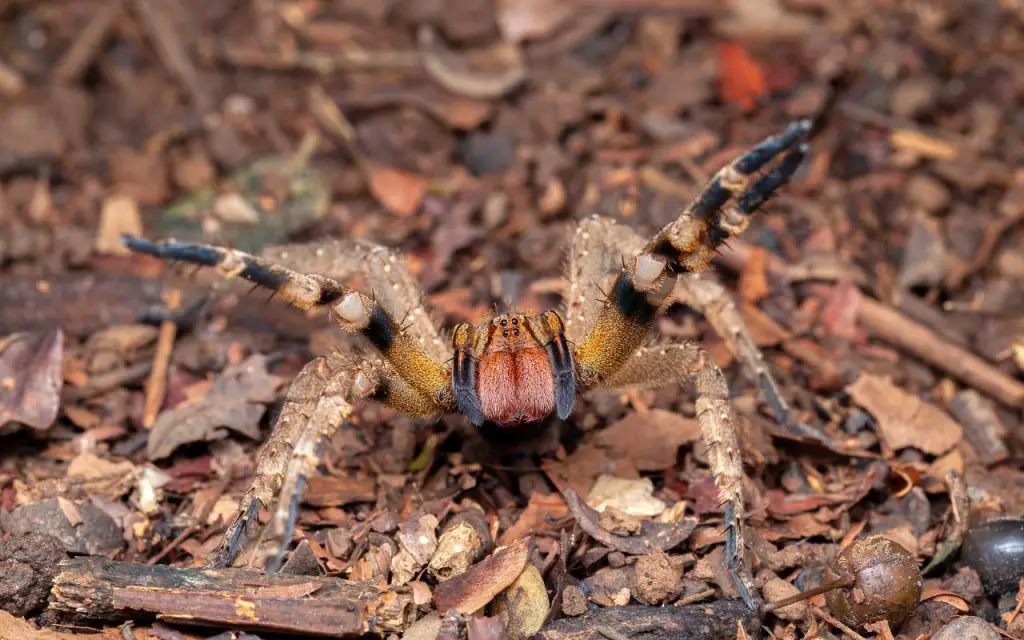
Brazilian Wandering Spider Speed
An adept hunter, the Brazilian Wandering Spider can move quickly when chasing prey or evading threats. While exact speed measurements can vary, some sources report that these spiders can achieve speeds up to 1 meter per second.
What Does the Brazilian Wandering Spider Eat?
The Brazilian Wandering Spider’s diet consists mainly of insects, other spiders, and occasionally small amphibians and reptiles. Their potent venom allows them to tackle prey larger than themselves, making them one of the apex micro-predators in their habitat.
Final Thoughts…
While the Brazilian Wandering Spider might seem terrifying to many, as an arachnid enthusiast, I find them to be incredibly fascinating. Their potent venom, hunting prowess, and adaptation to diverse habitats reveal the intricate beauty of the evolutionary process.
Just remember, these spiders, like all creatures, play a vital role in our ecosystem. Respect, not fear, should be our response to these remarkable arachnids.
The truth is that most bites are accidental, but they do occur. The fact that so few deaths occur each year is a testament to the effectiveness of the antivenom that has now become widely available.
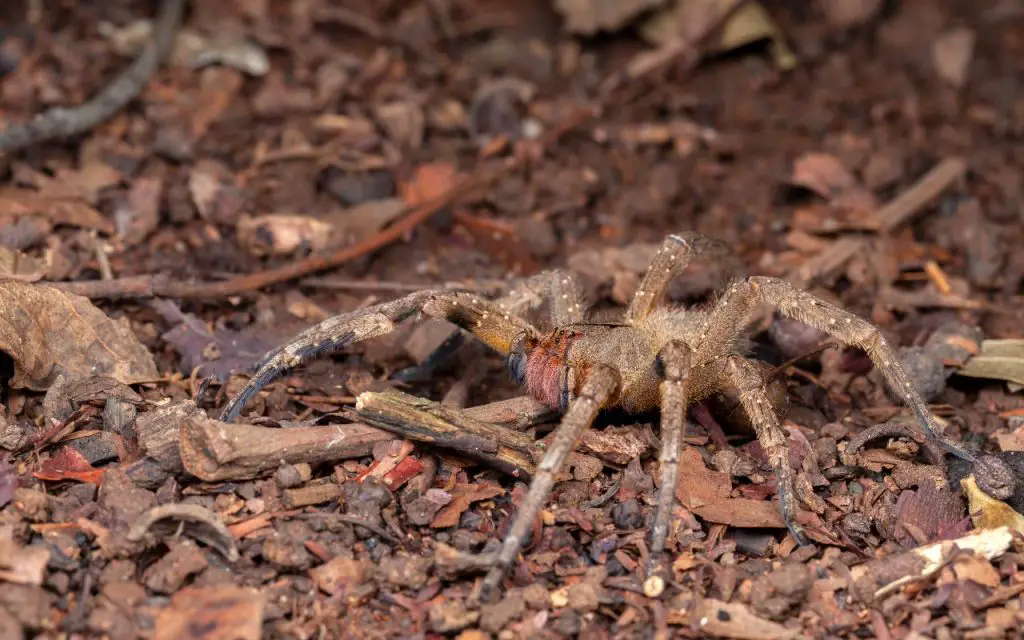
FAQ related to the Brazilian Wandering Spider
What happens if you are bitten by a brazilian wandering spider.
Immediately after a bite from a Brazilian Wandering Spider, you will experience localized pain. Then, within 5 to 15 minutes the area around the bite will swell. The swelling can spread to most of a limb, for example. Finally, neurological symptoms like coldness, sweating, and convulsions will set in.
Do wandering spiders jump?
Wandering Spiders are excellent at jumping. They can jump several feet when surprised, and may occasionally use this as a tactic to evade predators. Jumping at you isn’t part of how bites happen though. When faced with humans, Wandering Spiders usually stand their ground and use their threat display of raised legs to warn us away.
Is Brazilian wandering spider friendly?
Wandering Spiders are not friendly. As a general rule, they are relatively calm, but can also be defensive. They tend to see humans as a threat, and will not take to being handled easily. That said, they are not aggressive, and most bites happen when someone accidentally touches one or tries to kill it.
Are Brazilian wandering spiders in Australia?
Brazilian Wandering Spiders are not found in Australia. The only species in Australia that get as large as Wandering Spiders are the Huntsman Spiders. At a distance they may appear relatively similar, but Huntsman Spiders are completely harmless to humans.
Related Posts:
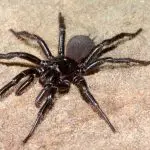
Leave a Comment Cancel Reply
Your email address will not be published. Required fields are marked *
Save my name, email, and website in this browser for the next time I comment.
Brazilian wandering spiders: Bites & other facts
Brazilian wandering spiders don't build webs but crawl on the forest floor at night in search of prey, which they kill with neurotoxic venom.
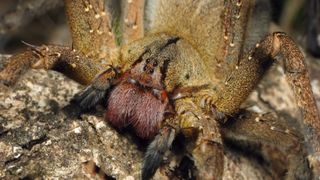
Classification/taxonomy
Size & characteristics, bites and venom, additional resources.
Brazilian wandering spiders are aggressive spiders that belong to the genus Phoneutria, which means "murderess" in Greek.
These critters, also known as armed spiders or banana spiders, are some of the most venomous spiders on Earth. Their large mouthparts, or chelicerae, inflict painful bites loaded with neurotoxic venom that can be deadly to humans — especially children — although in most cases immediate medical care can prevent death with antivenom, according to a 2018 study in the journal Clinical Toxinology in Australia, Europe, and Americas .
Brazilian wandering spiders are frequently listed among the deadliest spiders in the world . They were named the world's deadliest spiders multiple times by Guinness World Records, although the current record-holder is the male Sydney funnel-web spider ( Atrax robustus ). But "classifying an animal as deadly is controversial," Jo-Anne Sewlal, an arachnologist at the University of the West Indies in Trinidad and Tobago, previously told Live Science. Each bite is unique, and the damage it causes depends on the amount of venom injected, Sewlal said.
Jo-Anne Sewlal was a noted arachnologist from Trinidad and Tobago. While completing her PhD, she received the National Institute of Higher Education, Research, Science and Technology (NIHERST) 2012 Award for Excellence in Science and Technology for Junior Scientist. In 2013, She received a doctorate in zoology from the University of the West Indies. She discovered several species of spiders in her home country, surveyed the arachnids across several countries the Caribbean and appeared as an expert on the topic on The Science Channel. She died of an allergic reaction in January 2020.
There are nine species of Brazilian wandering spider, all of which are nocturnal and can be found in Brazil. Some species also can be found throughout Central and South America, from Costa Rica to Argentina, according to a 2008 article in the journal American Entomologist . Study author Richard S. Vetter , a research associate in the department of entomology at the University of California, Agriculture and Natural Resources, wrote that specimens of these powerful arachnids have been mistakenly exported to North America and Europe in banana shipments. However, Vetter noted, in many cases of cargo infestation, the spider in question is a harmless banana spider (genus Cupiennius ) that is misidentified as a Phoneutria . The two types of spiders look similar.
The taxonomy of Brazilian wandering spiders, according to the Integrated Taxonomic Information System (ITIS) , is:
Kingdom : Animalia
Subkingdom : Bilateria
Infrakingdom : Protostomia
Superphylum : Ecdysozoa
Phylum : Arthropoda
Subphylum : Chelicerata
Class : Arachnida
Order : Araneae
Family : Ctenidae
Genus : Phoneutria
- Phoneutria bahiensis
- Phoneutria boliviensis
- Phoneutria eickstedtae
- Phoneutria fera
- Phoneutria keyserlingi
- Phoneutria nigriventer
- Phoneutria pertyi
- Phoneutria reidyi
- Phoneutria depilata , according to a 2021 study published in the journal ZooKeys , which found that Phoneutria boliviensis actually included two separate species from different habitats.
Brazilian wandering spiders are large, with bodies reaching up to 2 inches (5 centimeters) and a leg span of up to 7 inches (18 cm), according to the Natural History Museum in Karlsruhe, Germany. The species vary in color, though all are hairy and mostly brown and gray, although some species have lightly colored spots on their abdomen. Many species have bands of black and yellow or white on the underside of the two front legs, according to the University of Florida .
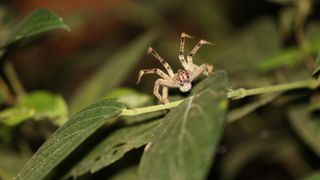
These arachnids "are called wandering spiders because they do not build webs but wander on the forest floor at night, actively hunting prey," Sewlal told Live Science in an interview conducted in 2014, before her death. They kill by both ambush and direct attack.
They spend most of their day hiding under logs or in crevices, and come out to hunt at night. They eat insects, other spiders and sometimes, small amphibians, reptiles and mice.
Research into one species of Brazilian wandering spider, Phoneutria boliviensis , revealed that these spiders eat a mix of arthropods and reptiles. DNA metabarcoding, a technique that examines the DNA and RNA in a sample, of the guts of 57 spiders identified 96 prey species, including flies, beetles, butterflies, moths, grasshoppers, locusts and crickets, according to research from the University of Tolima and the University of Ibagué in Colombia . Some of the female spiders also ate lizards and snakes.
While their bites are powerful and painful, "their bites are a means of self-defense and only done if they are provoked intentionally or by accident," Sewlal said.
When Brazilian wandering spiders feel threatened, they often assume a defensive position by standing on their hind legs and stretching out their front legs to expose their fangs, according to the 2018 study in Clinical Toxinology in Australia, Europe, and Americas. This posture is sometimes accompanied by side-to-side movements. The spiders can also jump distances up to 1.3 feet (40 cm).

In the Brazilian wandering spider, just as in most spider species, the female is larger than the male. Males approach females cautiously when attempting to mate, according to the biology department at the University of Wisconsin-La Crosse . Males perform a dance to get females' attention, and males often fight each other over the female. The female can be picky, and she often turns down many males before choosing a mating partner. Once she does pick one, the male needs to watch out; females often attack the males once copulation is finished.
The female then can store the sperm in a separate chamber from the eggs until she is ready to fertilize them. She will lay up to 1,000 eggs at a time, which are kept safe in a spun-silk egg sac.
Brazilian wandering spiders typically live for one or two years.
Brazilian wandering spiders' venom is a complex cocktail of toxins, proteins and peptides, according to the Natural History Museum in Karlsruhe, Germany. The venom affects ion channels and chemical receptors in victims' neuromuscular systems.
After a human is bitten by one of these spiders, they may experience initial symptoms such as severe burning pain at the site of the bite, sweating and goosebumps, Sewlal said. Within 30 minutes, symptoms become systemic and include high or low blood pressure , fast or a slow heart rate , nausea, abdominal cramping, hypothermia, vertigo, blurred vision, convulsions and excessive sweating associated with shock. People who are bitten by a Brazilian wandering spider should seek medical attention immediately.
Their venom is perhaps most famous for triggering painful and long-lasting erections . For that reason, in a 2023 study, scientists reported that they were testing the venom in humans as a potential treatment for erectile dysfunction in those for whom Viagra didn't work.

However, these bites are rare, and envenomations, or exposure to these toxins from a spider bite, are usually mild, Vetter said. For instance, a 2000 study in the journal Revista do Instituto de Medicina Tropical de São Paulo found that only 2.3% of people with bites who came to a Brazilian hospital over a 13-year period were treated with antivenom. (The other bites did not contain enough venom to require it.) Most of the bites were from the species P. nigriventer and P. keyserlingi in eastern coastal Brazil. About 4,000 bites reportedly happen each year in Brazil, but only 0.5% of those cases are severe, according to the 2018 study. Meanwhile, 15 deaths have been attributed to Phoneutria in Brazil since 1903, the 2018 study reported.
"It is unlikely that the spider would inject all of its venom into you, as this venom is not only needed as a means of defense but to immobilize prey," Sewlal said. "So if it did inject all of its venom, it [would] have to wait until its body manufactured more before it could hunt." That would also leave the spider vulnerable to being attacked by predators.
Furthermore, Sewlal pointed out that venom production requires a lot of a spider's resources and time. "So if the spider were to attack frequently and use up all of its venom, it [would] be safe to assume that it has a ready food supply to replace the energy and resources used. This situation does not exist in the wild."
- Learn more about Brazilian wandering spiders from the University of Wisconsin-La Crosse .
- Read about several species of Brazilian wandering spiders, including several images of the arachnids at the University of Florida .
- Find a spider in your bananas? It may or may not be a deadly species, according to the University of California, Riverside .
This article was originally published on Nov. 20, 2014.
Sign up for the Live Science daily newsletter now
Get the world’s most fascinating discoveries delivered straight to your inbox.
Jessie Szalay is a contributing writer to FSR Magazine. Prior to writing for Live Science, she was an editor at Living Social. She holds an MFA in nonfiction writing from George Mason University and a bachelor's degree in sociology from Kenyon College.
- Laura Geggel Editor
- Sascha Pare Trainee staff writer
3 remarkable spiders: A vegetarian, a vampire and a predator that uses 'pincer, fork and key'
We now know why tarantulas are hairy — to stop army ants eating them alive
Hurricane Milton: Jaw-dropping images taken from space show the storm rapidly intensifying as it approaches Florida
Most Popular
- 2 Earth from space: Beautiful 'lake of haze' in Himalayan valley has a darker, more sinister source
- 3 2,800-year-old burial mound with sacrifices unearthed in Siberia is eerily similar to Scythian graves
- 4 Why NASA is sending the Europa Clipper to search for aliens near Jupiter
- 5 'Any protein you can imagine, it can deliver': AI will help discover the next breakthrough in RNA, says Nobel Prize winner Dr. Drew Weissman

Brazilian wandering spider | bite,Size, Habitat, & Facts
Brazilian wandering spider.
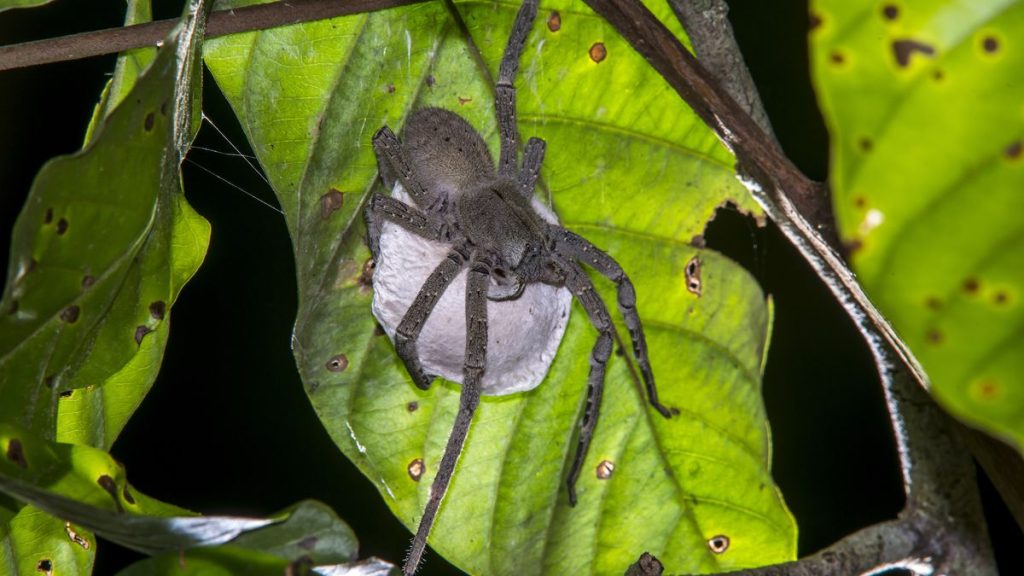
brazilian wandering spider size
Their body length ranges from 17 to 48 mm (43⁄64 to 1+57⁄64 in). Phoneutria are impressive spiders reaching body sizes up to 3.5 centimeters and leg spans up to 15 centimeters. They are nocturnal, hunting at night, and hiding in dark places during the day.
Wandering spider bite
Along with other members of the genus, they are often referred to as Brazilian wandering spiders. Its bite can cause severe symptoms, including increased pulse, blood pressure, and respiratory rate; extraordinary pain; penile erection that lasts for several hours; and, in several documented cases, death.
Phoneutria spp. is actually a genus with five known similar species whose members are highly venomous. They include some of the relatively few species of spiders that present a threat to human beings. The Brazilian Wandering Spider (Phoneutria fera) can grow to have a leg span of up to 4-5 inches.
Wandering spider, (family Ctenidae), any member of the family Ctenidae (order Araneida), a small group of large spiders of mainly tropical and subtropical regions, commonly found on foliage and on the ground.
The Brazilian wandering spiders, Phoneutria fera and P. nigriventer, are sometimes also referred to as banana spiders because they are frequently found on banana leaves. They have an aggressive defense posture, in which they raise their front legs straight up into the air. Phoneutria are venomous, and their venom is toxic to the nervous system, causing symptoms such as salivation, irregular heartbeat, and prolonged painful erections (priapism) in men. Scientists are investigating the venom of P. nigriventer as a possible treatment for erectile dysfunction.
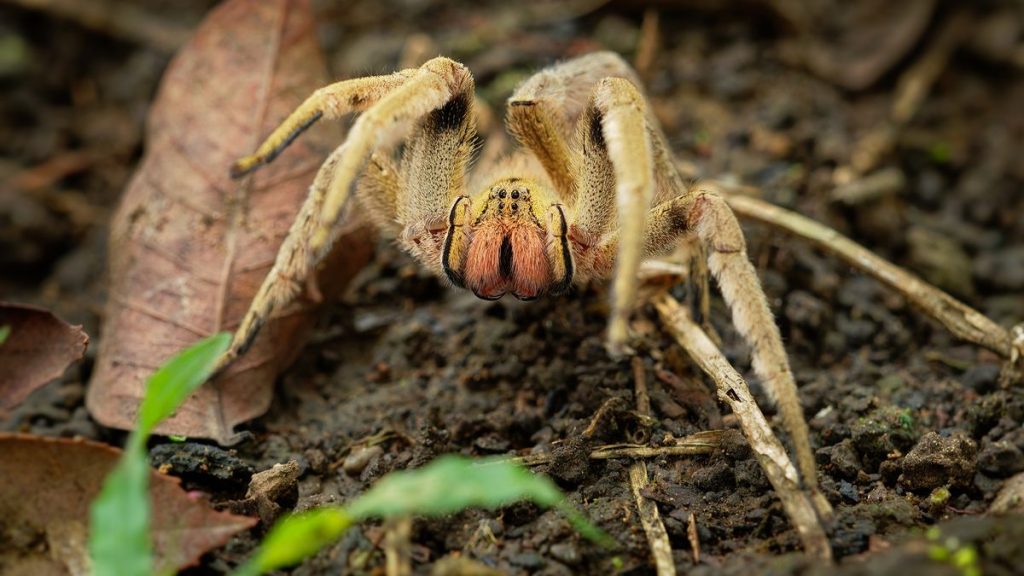
These spiders are notorious both due to their toxic venom, and because they are not reluctant to attack people who appear threatening.
Of the five species known, P. nigriventer and P. fera most frequently receive mention in mass-media publications. P.nigriventer species are responsible for most cases of venom intoxication in Brazil because this species is commonly found in highly populated areas of Brazil, namely the South-eastern states: São Paulo, Minas Gerais, Rio de Janeiro and Espírito Santo.The P. fera is native to the northern portion of South America, especially the Brazilian Amazônia, Venezuela and French Guiana.
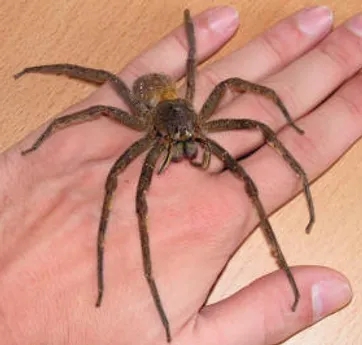
Brazilian wandering spider BITES AND VENOMB
razilian wandering spiders’ venom is a complex cocktail of toxins, proteins and peptides, according to the Natural History Museum in Karlsruhe, Germany. The venom affects ion channels and chemical receptors in victims’ neuromuscular systems.
After a human is bitten by one of these spiders, he or she may experience initial symptoms such as severe burning pain at the site of the bite, sweating and goosebumps, Sewlal said. Within 30 minutes, symptoms become systemic and include high or low blood pressure, fast or a slow heart rate, nausea, abdominal cramping, hypothermia, vertigo, blurred vision, convulsions and excessive sweating associated with shock. People who are bitten by a Brazilian wandering spider should seek medical attention immediately.
Recent studies suggest that these spiders only inject venom in approximately one-third of their bites and may only inject a small amount in another third. However, research in this area is hindered by the difficulty of identifying particular subspecies. Thus the effects of the bites from these spiders are hard to predict when based on sketchy information or if the spider has not been identified definitively.
Bites from these spiders may result in only a couple of painful pinpricks to full-blown envenomation. In either case, people bitten by a Phoneutria or any Ctenid should seek immediate emergency treatment as the venom is possibly life threatening.
he Phoneutria fera and nigriventer are the two most commonly implicated as the most virulent of the Phoneutria spiders. The Phoneutria not only has a potent neurotoxin, but is reported to have one of the most excruciatingly painful envenomations of all spiders due to its high concentration of serotonin.
Brazilian Wandering Spiders are extremely fast, extremely venomous, and extremely aggressive and are ranked among the most venomous spiders known to man. In fact, the Brazilian Wandering Spider is the most venomous spider in the New World! In South America, these true spiders are commonly encountered in peoples’ homes, supposedly hiding in peoples’ shoes, hats, and other clothes. It does not remain on a web, rather, it wanders the forest floor, which is how it got its name.
The Brazilian Wandering Spider has another name – the Banana Spider and it was given this name because there have been cases where these spiders unintentionally appeared on banana boats heading for the United States.
Brazilian Wandering Spider: One Of The World’s Most Venomous Spiders May Be Lurking In Your Bananas
Meet the Brazilian wandering spiders in the genus Phoneutria, also referred to as the armed spiders or the banana spiders. The members of this group have one of the most dangerous bites of any spider species on Earth and they have been classified as the world’s most venomous spider many times.
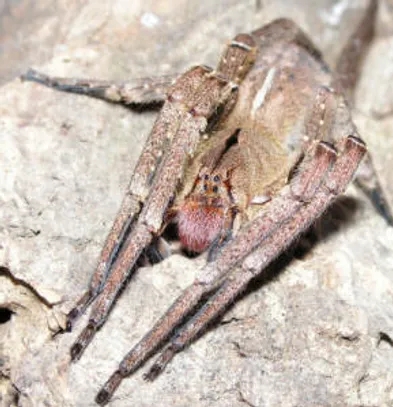
What Are The Effects Of A Brazilian Wandering Spider Bite?
Brazilian wandering spiders often make the news because of the unusual symptoms caused to humans after being bitten by one.
A 2023 study in Frontiers In Molecular Biosciences suggested there were around 4,000 cases of people being bitten by Phoneutria nigriventer in Brazil each year. Their venom affects the nervous system, causing double vision, salvation, irregular heartbeat – and even prolonged painful erections, known as priapism. In fact, because of this, their venom is being explored as a possible treatment for erectile dysfunction conditions.
Can A Brazilian Wandering Spider Bite Kill You?
The neurotoxin PhTx3 is to blame for these symptoms, and according to the Independent, a wandering spider bite can reportedly be fatal in as little as 60 minutes. However, an effective anti-venom is usually enough to save those affected. A study into Phoneutria boliviensis in 2019 suggested that the species had adapted its venom to catch vertebrates as opposed to lizards and amphibians, which might explain why the venom is so toxic to humans.
black and yellow garden spider
Brown recluse spider bite stages pictures.

IMAGES
VIDEO